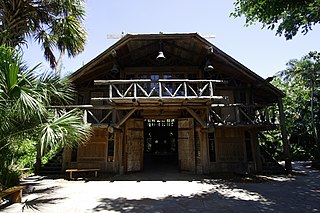
The McKee Botanical Garden is a non-profit, subtropical botanical garden in Vero Beach, Florida. It is located at 350 U.S. Highway 1, Vero Beach, Florida.

Chirita was a formerly recognised genus of plants in the family Gesneriaceae, native to the Indo-Malayan realm of South and Southeast Asia and southern China. In 2011, the species in the genus were reassigned to several genera, so that Chirita became a synonym, no longer recognized. The type species C. urticifolia was assigned to the genus Henckelia as H. urticifolia(Buch.-Ham. ex D. Don.) A. Dietr.
Stachytarpheta steyermarkii is a species of plant in the family Verbenaceae. It is endemic to Ecuador. Its natural habitat is subtropical or tropical moist montane forests.
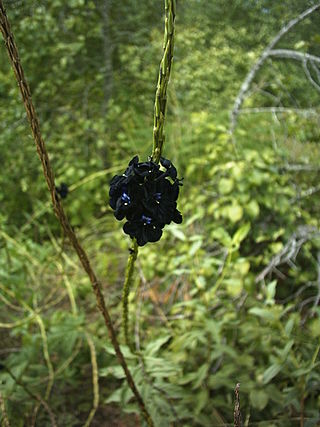
Stachytarpheta is a plant genus in the verbena family (Verbenaceae). The flowers are rich in nectar and popular with many butterflies, such as the South Asian crimson rose, Malabar banded swallowtail, and grass yellow Hummingbirds, especially small species like Lophornis coquettes, Chlorostilbon emeralds, and Discosura thorntails, are especially attracted for nectar. Several species in this genus are known as porterweeds.
Stachytarpheta svensonii is a species of plant in the family Verbenaceae. It is endemic to Ecuador. Its natural habitat is subtropical or tropical dry forests.

Verbena urticifolia, known as nettle-leaved vervain or white vervain, is a herbaceous plant in the vervain family (Verbenaceae). It belongs to the "true" vervains of genus Verbena.

Verbena hastata, commonly known as American vervain, blue vervain, simpler's joy, or swamp verbena, is a perennial flowering plant in the vervain family Verbenaceae. It grows throughout the continental United States and in much of southern Canada.
Agastache parvifolia is a species of flowering plant in the mint family known by the common name small-leaf giant hyssop. It is endemic to far northern California, where it grows in woodlands. It is an uncommon species and is sometimes considered a local subspecies of Agastache urticifolia.
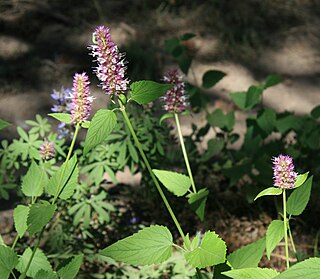
Agastache urticifolia is a species of flowering plant in the mint family known by the common name nettleleaf giant hyssop or horse mint.

Stachytarpheta jamaicensis is a species of plant in the family Verbenaceae, native throughout the Caribbean, including Florida. It has many common names including blue porterweed, blue snake weed, bastard vervain, Brazilian tea, Jamaica vervain, light-blue snakeweed, and, in St. Croix, worryvine.source? It usually is found along country roadsides, and it also grows well as a ruderal plant on disturbed terrain.

Salvia urticifolia is a herbaceous perennial native to the southeastern United States. S. urticifolia is an erect plant that reaches 20 to 70 cm tall. Flowers, with a corolla that is approximately 1.2 cm (0.47 in) long, are blue or purple, growing in panicles on short pedicels. The lower lip has three lobes, with a pair of white marks coming from the throat. The leaves are crenate—similar to the leaves of Urtica species.

Rhus michauxii is a rare species of flowering plant in the cashew family known by the common names false poison sumac and Michaux's sumac. It is endemic to the southeastern United States, where it can be found in the states of Virginia, North Carolina, South Carolina and Georgia. It is threatened by the loss and degradation of its habitat and by barriers to reproduction. It is a federally listed endangered species of the United States.
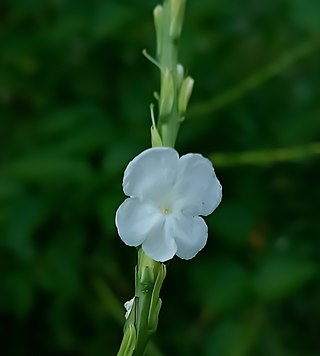
Stachytarpheta indica is a species of plant in the family Verbenaceae, native to the tropical Americas. It has often been included in the species S. jamaicensis.

Cleora acaciaria is a moth of the family Geometridae described by Jean Baptiste Boisduval in 1833. It is found in Angola, Cameroon, Comoros, Congo, Ghana, Madagascar, Réunion São Tomé and Príncipe and the United Arab Emirates.

Stachytarpheta mutabilis is a species of flowering plant in the verbena family known by the common names changeable velvetberry, coral porterweed, pink snakeweed, red snakeweed, and pink rat tail. It is native to Mexico, the Caribbean, and South America. It can be found in many other places as an introduced species. It is cultivated as an ornamental plant.

Phazaca theclata is a moth of the family Uraniidae. It was first described by Achille Guenée in 1858. It is known from Africa south of the Sahara, from Saudi Arabia, as well as from India, Japan, Myanmar, Nepal and Sri Lanka.

Ficus palmata, the Punjab fig, or "Bedu" is a plant in the family Moraceae. It is native to southern Egypt across to north-eastern tropical Africa and also the Arabian Peninsula. It is a shrub/tree with edible fruit.

Stachytarpheta cayennensis is a species of flowering plant in the verbena family known by many English language common names, including blue snakeweed, Cayenne snakeweed, dark-blue snakeweed, bluetop, nettle-leaf porterweed, rattail, rough-leaf false vervain, blue rat's tail, Brazilian tea, Cayenne vervain, false verbena, joee, nettleleaf velvetberry, and Cayenne porterweed. Names in other languages include honagasō (Japanese), gervão-urticante, piche de gato, rabo de zorro (Spanish), herbe á chenille, herbe bleue, queue de rat (French), ōi or ōwī (Hawaiian), sakura or ouchung (Chuukese), and tiāki (Māori). It is native to the Americas, from Mexico south through Central and South America to Argentina, as well as many islands of the Caribbean. It is known in many other parts of the world as an introduced species, including regions in Africa, India, Indonesia, Australia, Florida in the United States, and many Pacific Islands. Its distribution is now considered pantropical. In many places, such as New Caledonia, it has become an invasive species.
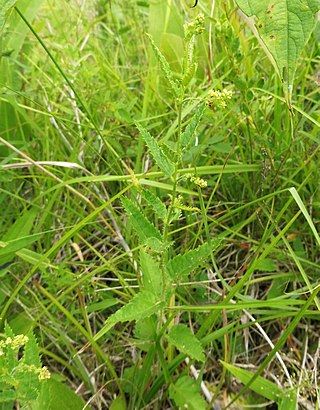
Tragia urticifolia, commonly called nettleleaf noseburn, is a species of flowering plant in the spurge family (Euphorbiaceae). It is native eastern to North America, where it is found in the southeastern United States. Its typical natural habitat is in rocky or sandy dry woodlands, over calcareous or mafic substrates.
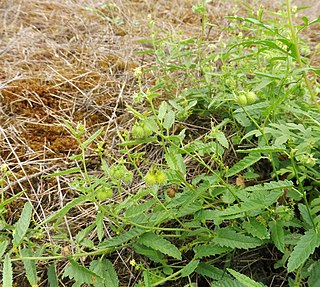
Tragia betonicifolia, commonly called betonyleaf noseburn, is a species of flowering plant in the spurge family (Euphorbiaceae). It is native to North America, where it is primarily found in the South-Central region of the United States extending north into Kansas and Missouri, with disjunct populations east in Tennessee. Its typical natural habitat is dry areas with sandy or rocky soil, in glades, prairies, bluffs, and dry woodlands.

















